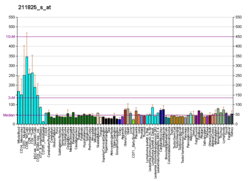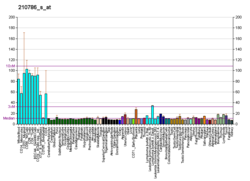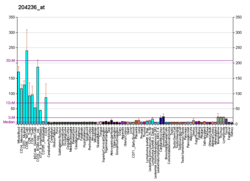Friend leukemia integration 1 transcription factor (FLI1), also known as transcription factor ERGB, is a protein that in humans is encoded by the FLI1 gene, which is a proto-oncogene.[5][6][7]
Function
Fli-1 is a member of the ETS transcription factor family that was first identified in erythroleukemias induced by Friend Murine Leukemia Virus (F-MuLV). Fli-1 is activated through retroviral insertional mutagenesis in 90% of F-MuLV-induced erythroleukemias. The constitutive activation of fli-1 in erythroblasts leads to a dramatic shift in the Epo/Epo-R signal transduction pathway, blocking erythroid differentiation, activating the Ras pathway, and resulting in massive Epo-independent proliferation of erythroblasts. These results suggest that Fli-1 overexpression in erythroblasts alters their responsiveness to Epo and triggers abnormal proliferation by switching the signaling event(s) associated with terminal differentiation to proliferation. [citation needed]
Clinical significance
In addition to Friend erythroleukemia, proviral integration at the fli-1 locus also occurs in leukemias induced by the 10A1, Graffi, and Cas-Br-E viruses. Fli-1 aberrant expression is also associated with chromosomal abnormalities in humans. In pediatric Ewing’s sarcoma a chromosomal translocation generates a fusion of the 5’ transactivation domain of EWSR1 (also known as EWS) with the 3’ Ets domain of Fli-1. The resulting fusion oncoprotein, EWS/Fli-1, acts as an aberrant transcriptional activator.[8] with strong transforming capabilities. EWS/Fli-1 may steer clinically important genes via interaction with enhancer-like GGAA-microsatellites.[9] The importance of Fli-1 in the development of human leukemia, such as acute myelogenous leukemia (AML), has been demonstrated in studies of translocation involving the Tel transcription factor, which interacts with Fli-1 through protein-protein interactions. A recent study has demonstrated high levels of Fli-1 expression in several benign and malignant neoplasms using immunohistochemistry.[citation needed]
A possible association with Paris-Trousseau syndrome has been suggested.[10]
References
Further reading
External links
- FLI1+protein,+human at the U.S. National Library of Medicine Medical Subject Headings (MeSH)
This article incorporates text from the United States National Library of Medicine, which is in the public domain.







